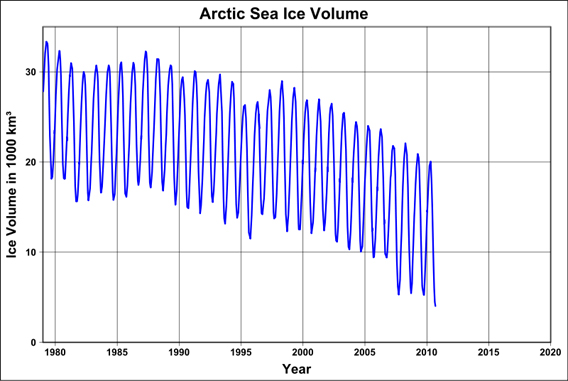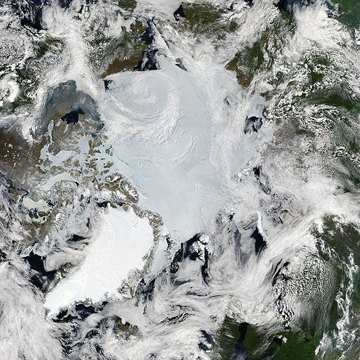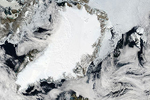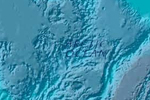
Scientists expect that the Arctic will be fully ice-free during summer sometime during this century. Graph by: Dominiklenne.
Kumi Naidoo, the head of Greenpeace, has been arrested after scaling a deepwater oil rig in the Arctic run by Cairn Energy. Naidoo was attempting to deliver a petition to the captain signed by 50,000 people demanding that Cairn Energy release details on how it would respond to an oil spill.
“For me and for many people around the world this is now one of the defining environmental struggles of our time,” Naidoo said on a video before scaling the rig. “It’s a fight for sanity against the madness that sees the disappearance of the Arctic ice not as a warning, but as an opportunity to seek further profits.”
According to Greenpeace, Naidoo and another activist were fired on by high-powered water canons as they climbed the ladder to the rig. On reaching the top they were arrested and flown by helicopter to Greenland to face charges.
Naidoo’s action follows on the heels of twenty Greenpeace activists arrested for attempting to stop Cairn’s oil drilling. Two activists—enclosed in a survival capsule hanging from the rig—stopped activities for four days.
 The Arctic as viewed by NASA’s MODIS Satellite in June 2010. Greenland is the bright island on the bottom-left. |
Last week, Cairn succeeded in receiving an injunction against Greenpeace in a Dutch court whereby Greenpeace faces a penalty of 50,000 Euros for everyday it refuses to comply. Still, Naidoo decided to take action himself.
“Fossil fuel—oil, gas, and coal—driven climate change, is already making life hard for millions of people. I have seen this first hand in Africa where I come from. Throughout the world, sadly, it is the people in poor countries who are facing the first, and the most brutal, impacts of climate change. All of us who care about the future of our children and grandchildren, we have to draw the line somewhere. And I say that we draw that line here in the Arctic,” Naidoo, a South African native, said before being arrested.
Naidoo is no stranger to arrests: battling apartheid in his home country he was arrested several times. A Rhodes scholar with a PhD in politics, he is the first African to head Greenpeace.
A Greenpeace representative recently told mongabay.com that the reason they are targeting Cairn Energy is because “they are the only company drilling in the Arctic this year.” The company is planning to drill up to four wells this summer off of Greenland.
As to the demand to release its oil spill plan, Cairn Energy told mongabay.com: “Working closely with the Greenland authorities, Cairn has developed an extensive oil spill response plan and tiered response capability. Cairn takes its responsibilities such as oil spill response very seriously.”
But Greenpeace responded that if “[their] plan is so reassuring, release it and reassure us.”
Greenpeace contends that given the extreme conditions of the Arctic, including that work is only feasible during the short Arctic summer, an oil spill could prove potentially impossible to clean up.
The organization says it will now leave the Arctic, but they are “taking the campaign against dangerous Arctic oil drilling to other places, and that’s where we’ll be for the rest of the year.”
The melting of the sea ice in the Arctic due to climate change has opened up a resource rush with a number of nations planning to exploit oil and gas, as well as fisheries, in the region. Greenpeace wants to see an international Arctic refuge, which would protect the entire extent of historical sea ice from industrial exploitation.
Related articles
Arctic on the line: oil industry versus Greenpeace at the top of the world

(06/06/2011) At the top of the world sits a lone region of shifting sea ice, bare islands, and strange creatures. For most of human history the Arctic remained inaccessible to all but the hardiest of peoples, keeping it relatively pristine and untouched. But today, the Arctic is arguably changing faster than anywhere else on Earth due to global climate change. Greenhouse gases from society have heated up parts of the Arctic over the past half-century by 4-5 degrees Fahrenheit, leading to a staggering decline in the Arctic sea ice. The large-scale changes suffered by the Arctic have created a new debate over conservation and exploitation, a debate currently represented by the protests of Greenpeace against oil company Cairn Energy, both of whom have been interviewed by mongabay.com (see below).
Russia and Norway carve up wildlife-rich Arctic sea for fossil fuels
(06/09/2011) As climate change melts the Arctic sea ice, nations are rushing to carve up once-inaccessible areas for oil and gas exploitation, industrial fishing, and shipping routes. Now, BBC reports that Russia and Norway have essentially agreed to split the Arctic’s Barents Sea in half —one of the region’s richest in biodiversity and ecological productivity—for industrial exploitation.
With pressure to drill, what should be saved in the Arctic?

(04/27/2011) Two major threats face the Arctic: the first is global climate change, which is warming the Arctic twice as fast the global average; the second is industrial expansion into untouched areas. The oil industry is exploring new areas in the Arctic, which they could not have reached before without anthropogenic climate change melting the region’s summer ice; but, of course, the Arctic wouldn’t be warming without a hundred years of massive emissions from this very same industry, thus creating a positive feedback loop that is likely to wholly transform the Arctic.